Toolbank
ToolBank is a registered term or 'word mark' registered with the U.S. Patent & Trademark Office used to identify the nonprofit tool lending program model created by the Atlanta Community ToolBank. Each ToolBank increases the impact of its local charitable sector by lending tools to organizations for use in the fulfillment of their missions. The available inventory of a typical ToolBank includes tools for landscaping, carpentry, plumbing, masonry as well as power tools, ladders, wheelbarrows, and others. The Atlanta Community ToolBank is currently the largest ToolBank in existence, with nearly 200 tool types in its lending inventory. The available inventory of the Atlanta Community ToolBank can be found here. As of December 31, 2016, eight ToolBanks are currently lending tools in Atlanta GA, Baltimore MD, Charlotte NC, Cincinnati OH, Houston TX, Phoenix AZ, Portland OR, and Richmond VA, with the Chicago Community ToolBank projected to open in the summer of 2016. The national network of ToolBanks is administered by the parent organization ToolBank USA, which was founded in 2008 to replicate the impact of the Atlanta ToolBank in cities beyond Atlanta. In 2014, ToolBank USA launched ToolBank Disaster Services, a program to deliver tools to communities affected by disaster. ToolBanks loaned $5.8M worth of tools and equipment to charitable organizations in 2015.
The ToolBank program model differs from the more common tool library model in that ToolBanks loan tools exclusively to other charitable organizations; ToolBank tools are not available to individuals. The ToolBank inventory is designated for the purpose of increasing the impact of the nonprofit sector and less formalized grassroots organizations. Typical borrowers of ToolBank tools include faith-based organizations, public schools, neighborhood organizations, public/private partnerships with community-oriented missions, social clubs with a service mission, gardening clubs, and others. Proof of charitable intent is verified prior to accessing ToolBank tools.
The ToolBank performs three primary functions:
1. Tool Lending: The ToolBank lends tools of all kinds for use in volunteer projects, facility maintenance and improvement projects, community improvement events, and special events.
2. Tool Advocacy: ToolBank staff advocates for the complete and timely return of all borrowed tools, to guarantee the long-term sustainability of available inventory. Staff also seeks compensation for lost tools and tools returned late.
3. Tool Maintenance: The ToolBank performs routine maintenance and repairs on all equipment to ensure good condition and to extend the lifespan of the inventory. This function is typically performed by volunteers and community service workers.
Through these three functions, local community organizations may benefit by:
ensuring that all participating volunteers are properly equipped;
engaging larger volunteer groups;
performing a broader scope of service projects;
engaging more highly skilled volunteers; and
eliminating tool purchase, repair, and storage costs.
ToolBank is a registered mark of the Atlanta Community ToolBank.[1] The Atlanta Community ToolBank granted a Right to License to ToolBank USA in 2008. ToolBank USA is a nonprofit organization created in February 2008, charged with the successful nationwide replication of the ToolBank program model. ToolBank USA was launched by a founding grant from The Home Depot Foundation.
History
The Atlanta Community ToolBank originated in Atlanta GA as an offshoot of a charitable no-cost home repair program known as Community Reinvestment Inc (CRI), founded in 1990. CRI's tool inventory grew organically as a result of volunteers donating equipment in support of the program. Local neighborhood associations and churches periodically borrowed CRI's tools for their own cleanup days and volunteer events, giving rise to the core concept of the ToolBank. The specific origin of the term ToolBank is unknown; CRI began offering the ToolBank as a formal program in 1992.
References
